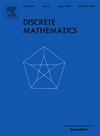Induced matching vs edge open packing: Trees and product graphs
IF 0.7
3区 数学
Q2 MATHEMATICS
引用次数: 0
Abstract
Given a graph G, the maximum size of an induced subgraph of G each component of which is a star is called the edge open packing number, , of G. Similarly, the maximum size of an induced subgraph of G each component of which is the star is the induced matching number, , of G. While the inequality clearly holds for all graphs G, we provide a structural characterization of those trees that attain the equality. We prove that the induced matching number of the lexicographic product of arbitrary two graphs G and H equals . By similar techniques, we prove sharp lower and upper bounds on the edge open packing number of the lexicographic product of graphs, which in particular lead to NP-hardness results in triangular graphs for both invariants studied in this paper. For the direct product of two graphs we provide lower bounds on and , both of which are widely sharp. We also present sharp lower bounds for both invariants in the Cartesian and the strong product of two graphs. Finally, we consider the edge open packing number in hypercubes establishing the exact values of when n is a power of 2, and present a closed formula for the induced matching number of the rooted product of arbitrary two graphs over an arbitrary root vertex.
诱导匹配与边缘开放填充:树和积图
给定一个图G,其每个组成部分都是星形的G的诱导子图的最大大小称为G的边开包数ρeo(G)。同样,G的每个组成部分都是星形的G的诱导子图的最大大小,1是G的诱导匹配数νI(G)。当不等式ρeo(G)≥νI(G)明显地适用于所有图G时,我们给出了那些达到相等的树的结构表征。证明了任意两个图G和H的字典积G°H的诱导匹配数等于α(G)νI(H)。通过类似的技术,我们证明了图的字典积的边缘开包数的尖锐的下界和上界,这特别导致了本文研究的两个不变量在三角形图中的np -硬度结果。对于两个图的直接积G×H,我们给出了νI(G×H)和ρeo(G×H)的下界,它们都是广锐的。我们也给出了两个图的笛卡尔不变量和两个图的强积的明显下界。最后,我们考虑了当n为2的幂时,在超立方体中建立ρeo(Qn)的精确值的边缘开包装箱数,并给出了任意两个图在任意根顶点上的根积的诱导匹配数的封闭公式。
本文章由计算机程序翻译,如有差异,请以英文原文为准。
求助全文
约1分钟内获得全文
求助全文
来源期刊

Discrete Mathematics
数学-数学
CiteScore
1.50
自引率
12.50%
发文量
424
审稿时长
6 months
期刊介绍:
Discrete Mathematics provides a common forum for significant research in many areas of discrete mathematics and combinatorics. Among the fields covered by Discrete Mathematics are graph and hypergraph theory, enumeration, coding theory, block designs, the combinatorics of partially ordered sets, extremal set theory, matroid theory, algebraic combinatorics, discrete geometry, matrices, and discrete probability theory.
Items in the journal include research articles (Contributions or Notes, depending on length) and survey/expository articles (Perspectives). Efforts are made to process the submission of Notes (short articles) quickly. The Perspectives section features expository articles accessible to a broad audience that cast new light or present unifying points of view on well-known or insufficiently-known topics.
 求助内容:
求助内容: 应助结果提醒方式:
应助结果提醒方式:


